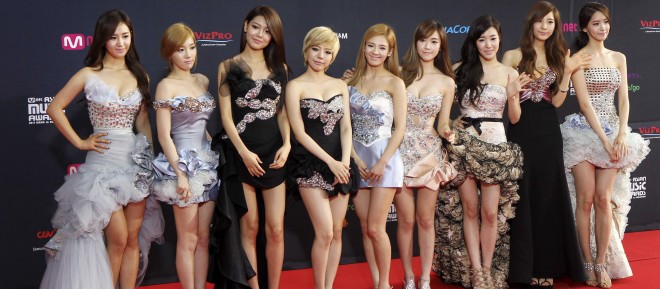Korean Pop: The next big thing?
The genre has its eyes set on the west, but K-Pop acts lack the myth making stories that North American audiences love
Share

Pinning a sonic identity to the latest decade is near impossible — indie rock buts up against house-infused R&B for chart-supremacy while modern rock radio continues to suffer from its late-’90s post-grunge hangover. Meanwhile, electronic dance music is the elephant in the room that few will admit is both an artistic and economic force.
So when Billboard created the K-Pop Hot 100 chart last August, it raised many industry eyebrows. Short for Korean pop music, fans and industry hawks forever searching for “the next big thing” believe an Eastern takeover could be on the horizon, something on which many in the beleaguered music biz are hell-bent on capitalizing. Which is precisely why it’s never going to happen.
K-pop is a sonic marriage of late-’90s boy- and girl-band aesthetics with surprisingly aggressive modern dance, hip-hop and R&B production with a dash of South Korea’s unique fashion sense. Sung in Korean, it’s weird, it’s different, and most importantly, it’s fun. As its name suggests, K-Pop is the music of choice in its native land, where teeming hordes scream along at concerts by such groups as 2NE1, Big Bang and the Wonder Girls. The genre has conquered Japan, made inroads into China’s exploding market and has its sights set on the West. K-pop’s celebrity landscape closely mirrors North America’s, with its own stars, romances and scandals, even if a forged degree — something Epik High member Tablo has been accused of — counts as a scandal. But like any cultural wave, a lot of factors need to be in place if a trend is going to catch fire.
Following the release of their first North American album, the Boys, on Interscope, Korean pop group Girls Generation made their network TV debut on the Late Show with David Letterman. The broadcast followed a string of think pieces on this strange new musical phenomenon. But North American audiences have proven fairly xenophobic when it comes to new sounds with foreign sensibilities. So acceptance on a massive scale is doubtful. The mothers of America aren’t likely to embrace Super Junior’s Heechul the way they did Justin Timberlake.
Even UK bands struggle to crack the states. European fans were early adopters of Backstreet Boys and N’Sync. But when their own pop acts like Boyzone and 5ive tried to duplicate their homegrown success across the pond, only the Spice Girls stuck. The unique personalities ascribed to each member had a lot to do with their success. The sprawling memberships of Korea’s pop groups on the other hand, (there are nine members in Girls Generation, One Day [2AM was one of the two sub-groups] had 11 before splintering into two subgroups) are presented as monolithic entities, and have yet to define themselves from one another. How will audiences build up and tear down artists if they can’t tell one from another?
Similarly, these groups lack a narrative. Think of any major Western act and you can probably attach some sort of story to them when they broke – 50 Cent was shot nine times, Justin Bieber was discovered on YouTube, Katy Perry kissed a girl and liked it. The K-pop industry circles around a trio of management companies in Seoul that operate more like modeling agencies, keeping artists under contract, and moving them around until they find a good fit. The formula clearly works, but it lacks the “born to be” myth-making stories of so many Western groups whose origins are no less manufactured. There’s a lot of buzz for the genre, and while Girls Generation and Wonder Girls have taken stabs at touring in North American, no single group has yet to separate itself from the pack.
Most of that buzz has come from the music press, both on and off line. “True” music fans usually consider pop a cultural wasteland, but ambitious production and sticky hooks catapulted event such tracks as Britney Spears Toxic and Rihanna’s Umbrella onto hipster radars. K-pop satisfies the pop itch while remaining outside the mainstream. Don’t expect these fickle listeners to have too much interest in promoting the music past their established circles. Wide acceptance of the genre would kill half of its appeal.
But perhaps the greatest threat to K-pop’s success in North America is the reigning pop royalty. Much to everyone’s surprise, boy bands like One Direction and the Wanted are inspiring fits of frenzied fandom from teenage girls. And Justin Bieber and his 18 million Twitter followers still carry sway with the tween set. They clash regularly with muckraking K-pop fans over which side is musically superior. It’s a battle neither side’s likely to win as the K-pop and Bieber’s music are so closely related it really comes down to a matter of taste and cultural orientation.
K-pop isn’t going away; its massive success overseas guarantees that Eastern audiences get to decide when its time is up. In the meantime, it’s certain to have an influence on North American acts — Heart2Heart, a modern boy-band managed by former N’Sync member Lance Bass, has latched onto K-pop’s dance moves, fashion sense and sonic palette — but financially they will continue to operate on the margins. The quicker labels realize this the better, because nothing ruins a good thing like a guy in a suit trying to sell it to you.